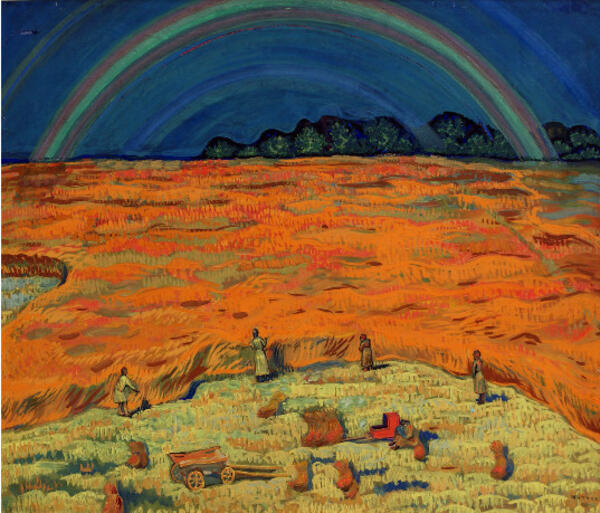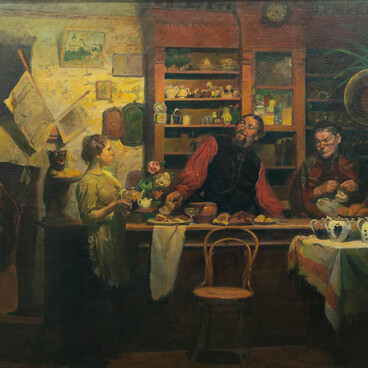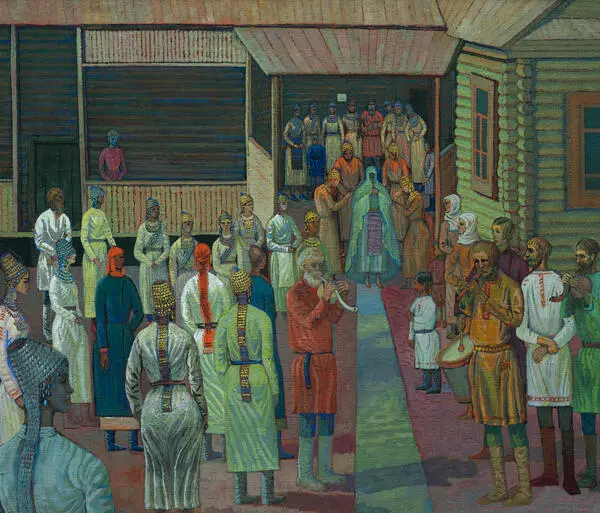Anatoly Ivanovich Mittov was one of the first artists to express national coloring in Chuvash art. He was born December 13, 1932, in the village of Toburdanovo, Kanash district, Chuvash Republic. He graduated from the graphics department at the Repin Leningrad Institute of Painting, Sculpture and Architecture. He turned to the historical and folklore aspects of his people’s lives as early as his student years. He discovered themes that became important for him while working on his graduation work and illustrations for the poem “Narspi”.
The artist’s works include illustrations for the poem “Narspi” by Konstantin Ivanov, the easel series of paintings based on “Narspi”, the series “Chuvash Antiquity”, the triptych “The Tale of the Volga” and others.
The series “Land of Our Ancestors”, which has become a classic, turned a completely new leaf in the history of Chuvash art. With each painting of the series, the artist seemed to accumulate inspiration for new series, themes, and cycles. This series was so impressive that the artist was immediately dubbed “the singer of antiquity”. The plots of the series “Land of Our Ancestors” are concise, with minimal naturalism. The artist showed the great truth of the life that he was taught and which he loved. The series includes seven paintings, five of which are presented in the museum. Each of the paintings from this series had its own coloring. The choice of color depended on its emotional and symbolic characteristics. That is why, despite the fact that each object has its own color, the coloring within one work is always homogeneous.
Anatoly Mittov was often reproached that his painting “Harvest” was an imitation of Van Gogh. But Van Gogh was primarily a source of inspiration for the artist, and the main similarity here is in the anxious, hypnotizing expressive power of color. Till the end of his life, Mittov worshiped the art of the Dutch artist, who was one of the most prominent contributors to the development of 20th-century painting throughout the world.
The artist’s main idea of this painting is reflected in a surprising comparison of the earth’s flattened surface with the raised vertical line of the sky, where people are part of the eternal universe.
The artist’s works include illustrations for the poem “Narspi” by Konstantin Ivanov, the easel series of paintings based on “Narspi”, the series “Chuvash Antiquity”, the triptych “The Tale of the Volga” and others.
The series “Land of Our Ancestors”, which has become a classic, turned a completely new leaf in the history of Chuvash art. With each painting of the series, the artist seemed to accumulate inspiration for new series, themes, and cycles. This series was so impressive that the artist was immediately dubbed “the singer of antiquity”. The plots of the series “Land of Our Ancestors” are concise, with minimal naturalism. The artist showed the great truth of the life that he was taught and which he loved. The series includes seven paintings, five of which are presented in the museum. Each of the paintings from this series had its own coloring. The choice of color depended on its emotional and symbolic characteristics. That is why, despite the fact that each object has its own color, the coloring within one work is always homogeneous.
Anatoly Mittov was often reproached that his painting “Harvest” was an imitation of Van Gogh. But Van Gogh was primarily a source of inspiration for the artist, and the main similarity here is in the anxious, hypnotizing expressive power of color. Till the end of his life, Mittov worshiped the art of the Dutch artist, who was one of the most prominent contributors to the development of 20th-century painting throughout the world.
The artist’s main idea of this painting is reflected in a surprising comparison of the earth’s flattened surface with the raised vertical line of the sky, where people are part of the eternal universe.




